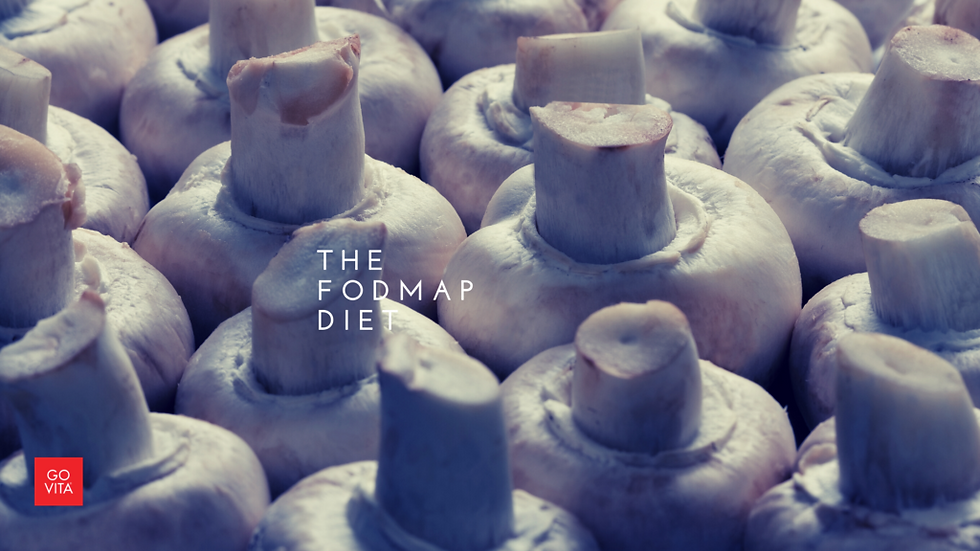Relief for IBS
- Go Vita

- Dec 1, 2020
- 4 min read
Updated: Dec 10, 2020
Written By Go Vita

ARE YOU ONE OF THE 20 PER CENT OF AUSTRALIANS WHO SUFFERS FROM IBS? READ ON TO DISCOVER IF SHORT-CHAIN CARBS (FODMAPS) ARE THE CULPRIT.
The old saying “An apple a day keeps the doctor away” is not always true; in fact, the humble apple can actually create wind, pain and bloating. In 2006, when Monash University researchers were developing the low FODMAP diet, they discovered that high-FODMAP foods, like apples, can be both friend and foe to the body, depending on an individual’s sensitivity to them. Since then, doctors, dietitians and nutritionists have widely recommended the low FODMAP diet as a treatment for irritable bowel syndrome (IBS), with very successful results
BEAT THE BLOAT
Do you regularly experience a distended tummy, embarrassing wind, abdominal pain, and constipation or explosive diarrhea? And do these symptoms persist even after you have eliminated common causes of digestive disorders, such as alcohol, caffeine, dairy, hot spices, legumes and ultra-processed foods? If so, a possible diagnosis of IBS may be confirmed by your healthcare provider, after they have ruled out coeliac disease, colon cancer, inflammatory bowel disease, parasites, small intestinal bacterial overgrowth(SIBO), and other digestive disorders.
If you do have IBS, the good news is that the low FODMAP diet is a scientifically supported and drug-free treatment method that results in significant improvement in three out every four people with the condition. The not-so-good news is that considerable discipline is required in order to follow the three-phase process of restriction, reintroduction and maintenance. The Monash Uni Low FODMAP Diet™ provides great guidance and support, including recipes, detailed food information, a food diary, symptom recorder, shopping lists, tutorial and feedback channels to the FODMAP team– all for around just $10.00.
Doctors, dietitians and nutritionists have widely recommended the low FODMAP diet as a treatment for irritable bowel syndrome (IBS), with very successful results.
FOLLOW THE FODMAP PATH
FODMAPs are short-chain carbohydrates that many people find difficult to digest, and they include an extensive list of fermentable oligosaccharides (eg. onions), disaccharides(eg. Lactose in some dairy products),monosaccharides (eg. Excess fructose like in honey) and polyols (eg. Sorbitol as in apples and peaches). FODMAPs pass through the small intestine attracting water as they go, which causes bloating, when they reach the large intestine they are fermented by healthy bacteria that live there, producing gas.
These two things cause extreme discomfort – in fact, one study found that IBS patients said they would trade an average of 25 per cent of their remaining life span if it meant being symptom-free. The low FODMAP diet classifies foods along a ‘traffic light’ system, ranging from low (green) through to moderate (orange)and high (red) – see box “Seeing Red” for examples of high FODMAP foods. Low FODMAP foods may be substituted for high FODMAP foods from the same food group; for example, wheat can be replaced with oats, rice or quinoa.
Serving sizes also determine a FODMAP rating; for example, 10 almonds equates to a low FODMAP serving size, but 20 almonds is considered to be high FODMAP. Following a definitive IBS diagnosis, it is recommended to eliminate all high FODMAP foods for two to six weeks. High FODMAP foods may then be reintroduced, one at a time, and the reaction tested for three days. The food is then usually removed again while testing for tolerance to remaining fodmap groups. Finally, a personalised diet and meal plans that minimise the most poorly tolerated FODMAPs may be designed by a dietitian, naturopath or nutritionist.
Holistic health tips to soothe IBS stress and pain include taking moderate exercise, eating mindfully and slowly, sipping warm water, and gentle stomach massage.
SELECTING SUPPLEMENTS
Although there is an abundance of apps, blogs and cookbooks to educate people on how to follow a low FODMAP diet, confusion remains about medications and supplements, as these often contain FODMAPs. For example, any ingredient name ending in “ol” is likely to be high FODMAP.
Having first gained guidance from your healthcare practitioner, it is advisable to eliminate any non-essential supplements or medications that contain FODMAPs. If you are unsure about whether a product contains FODMAPs, ask your health consultant or the manufacturer.
Although the FODMAP app is regularly updated, not all supplements appear on it yet, so I sought advice from Jane Muir, Monash University dietitian and nutrition scientist. Muir explains: “Collagen has no carbs, so it is OK. Spirulina gets the green light, but other green powders are not yet FODMAP approved.
Aloe Vera is fine at a maximum of ¼ cupper day, but psyllium should be taken with caution because it draws water into the intestines.” Herbs and nutrients that are often prescribed by naturopaths to heal the gut, such as charcoal, liquor ice tea, glutamine, marshmallow, flaxseed and slippery elm, are all low FODMAP. Other stomach-soothing supplements include low FODMAP digestive enzymes, fennel leaf tea, and a bifidobacteria probiotic. However, prebiotic supplements like inulin and artichoke powder, along with whey protein powder, are high FODMAP. Protein powders which are permitted at the recommended dose include brown rice, egg, hemp and pea. Muir warns against excessive protein because it can ferment and produce toxic by-products, such as ammonia. However, if the protein is taken with a well-tolerated natural fibre, this will reduce the impact of the fermentation.







Comments